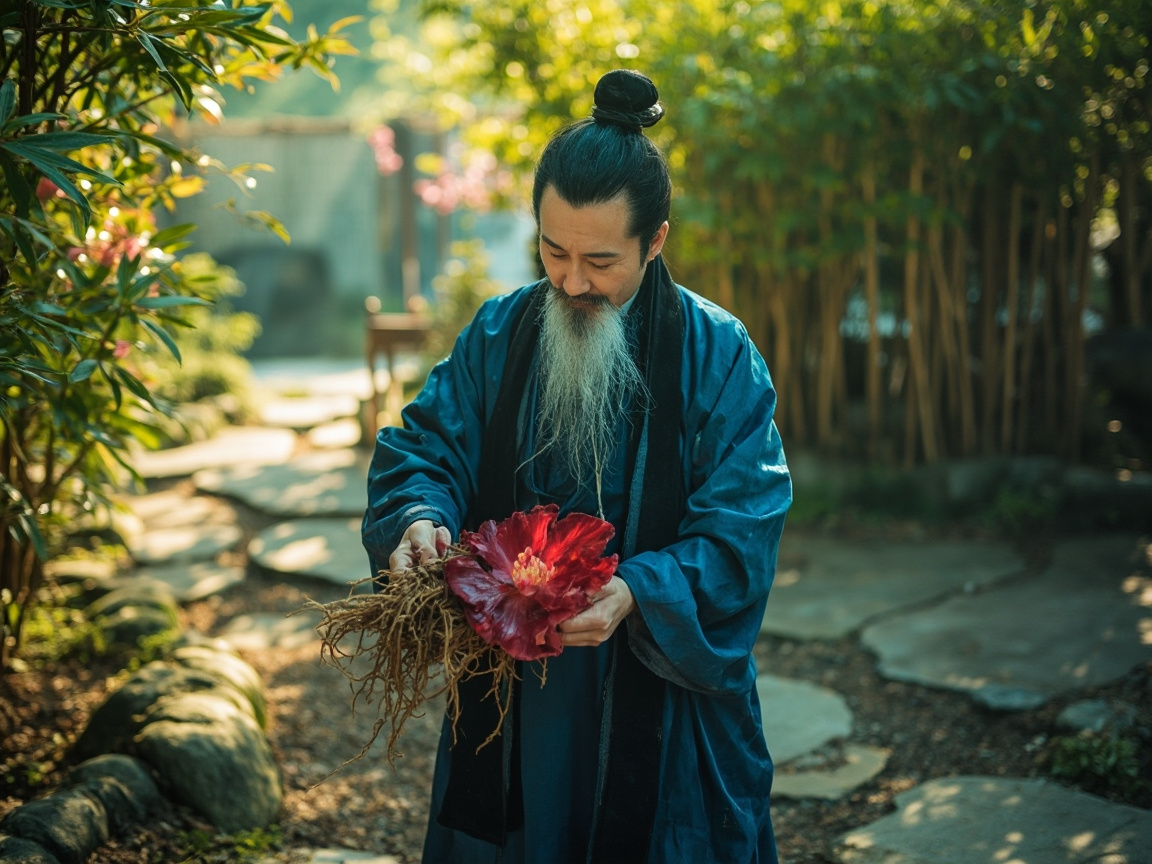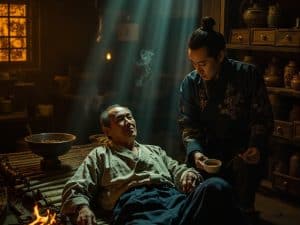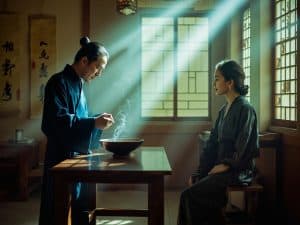Table of Contents
ToggleAnalysis of Traditional Chinese Medicine Medical Case 1: Fever, headache, nasal rales, nausea, sweating, aversion to wind
Author: Gu Yuxi Editor: Gu Yuxi Translator: Gu Yuxi
The medical case in traditional Chinese medicine comes from Ninety Discussions on Cold Damage By Xu Shuwei, Song Dynasty Discussion on the Use of Peony in Cinnamon Twig Decoction (1)
The original text is as follows
ma heng dao .geng xu chun bing .fa re .tou teng .bi ming .e xin .zi han .wu feng .wan ran gui zhi zheng ye .shi zei ma po yi zhen san ri yi .shi wu shao yao .zi zhi pu yuan .cai shao yao yi li ji .yi yi yue .ci chi shao yao er .an ke yong ye .yu yue .ci zheng dang yong .zai chuo er wei han jie .
lun yue .zhong jing gui zhi jia jian fa .shi you jiu zheng .dan yun shao yao .sheng hui fang .jie cheng chi shao yao .sun shang yao fang .jie yue bai shao yao .sheng hui fang .tai zong chao .han lin wang huai yin bian ji .sun zhao wei guo chao yi shi .bu ying ru ci bei li .ran chi zhe li .bai zhe bu .
yu chang yi ci nan ming yi .jie e ran shi cuo .jin an .shen nong ben cao .cheng .shao yao zhu xie qi fu tong .li xiao bian .tong shun xue mai .li pang guang da xiao chang .shi xing han re .ze quan shi chi shao yao ye .you gui zhi di jiu zheng yun .wei han zhe qu chi shao yao .gai ju shao yao zhi han ye .
wei shao yao gan cao tang yi zheng yun .bai shao yao .wei qi liang jing ju ji xue han ye .gu yong bai shao yao yi bu .fei ci shi ye .su wen yun .se zhe yang qi you yu ye .yang qi you yu .wei shen re wu han .yin qi you yu .wei duo han shen han .shang han 、mai se 、shen re wu han .gai xie zhong yin qi .gu yang you yu .fei ma huang bu neng fa san .zhong feng 、mai hua 、duo han 、shen han .gai xie zhong yang .gu yin you yu .fei chi shao yao bu neng gua qi yin xie .ran ze gui zhi yong shao yao chi zhe ming yi .dang can bai zheng ge .
Translation:
Ma Hengdao fell ill in the spring of the Gengxu year. He experienced fever, headache, nasal congestion, nausea, spontaneous sweating, and aversion to wind—symptoms clearly indicative of the Cinnamon Twig Decoction pattern. At that time, the enemy army had already breached Yizhen three days prior, and peony was unavailable in the market. I pointed to the peony in the patient’s garden and said, “Let’s use this.” A nearby physician remarked, “This is red peony; how can it be used?” I replied, “This is precisely what should be used.” After taking two doses, the patient began to sweat slightly, and his condition improved.
Xu Shuwei’s Commentary: Zhang Zhongjing’s modifications of Cinnamon Twig Decoction encompass nine out of ten patterns, yet he only mentions “peony,” without distinguishing between white and red peony. In the Sheng Hui Prescription, all instances refer to red peony, while in Sun Shang’s prescriptions, all mention white peony. The Sheng Hui Prescription was compiled during Emperor Taizong’s reign by Hanlin scholar Wang Huaiyin, and Sun Zhao served as an imperial physician of the Song Dynasty. They should not have diverged so significantly. However, red peony has a draining effect, whereas white peony is tonifying. I have posed this question to renowned physicians, and they were all astonished and at a loss.
Careful examination of the Shennong Materia Medica shows that peony is indicated for treating abdominal pain caused by pathogenic qi, promoting urination, unblocking the blood vessels, benefiting the bladder and intestines, and treating alternating chills and fever, all referring to red peony. In the ninth clause of Cinnamon Twig Decoction, it is stated that in cases of slight cold, red peony should be omitted, likely considering the cold nature of peony. Only in the Peony and Licorice Decoction is white peony mentioned, because the patient suffers from calf cramps caused by blood cold, requiring the tonifying effect of white peony. This is not the case here. In the Plain Questions, it is said that a choppy pulse indicates excessive yang qi. Excess yang manifests as body heat without sweating. Excess yin manifests as profuse sweating and cold body. In cold damage of the Taiyang stage, a choppy pulse with body heat and no sweating indicates that pathogenic qi has invaded the yin, causing an excess of yang, and only Ephedra can be used to disperse it. In wind stroke of the Taiyang stage, a slippery pulse with profuse sweating and cold body indicates that pathogenic qi has invaded the yang, causing an excess of yin, and only red peony can eliminate the yin pathogen. Therefore, it is evident that Cinnamon Twig Decoction should use red peony, and reference should be made to the Hundred Symptoms of Cold Damage Song.
【The thinking of syndrome differentiation and treatment in Traditional Chinese Medicine】:
【Differentiation of the Six Channels in Cold Damage】:
Xiaobiaobuli: None.
Taiyangbing:Present. Fever. Headache. Nasal congestion. Nausea. Spontaneous sweating. Aversion to wind.
Yangmingbing: None.Shaoyangbing:None. Shaoyinbing :None. Taiyinbing :None. Jueyinbing :None.
Differentiation of Miscellaneous Diseases:
Qixu: None. Xuexu : None. Shuiyin : None. Sushi : None. Tandu : None. Yuxue: None.
Other miscellaneous diseases: None.
Summary:
This is a very typical case of the Cinnamon Twig Decoction pattern. The illness developed in a textbook manner.
The corresponding chapter of this traditional Chinese medicine case in Treatise on Febrile Diseases and Miscellaneous Diseases:
bian tai yang bing mai zheng bing zhi shang 6.13——【6.13】tai yang zhong feng ,yang fu er yin ruo 。yang fu zhe ,re zi fa ;yin ruo zhe ,han zi chu 。se se wu han ,xi xi wu feng ,xi xi fa re ,bi ming gan ou zhe ,gui zhi tang zhu zhi 。
The nausea in this case is actually the same as the dry retching described in the differentiation section; dry retching involves no vomiting, only the sensation of wanting to vomit.
Interpretations of This Clause by Renowned Masters:
Hu Xishu: “Yang floating and yin weak” refers to the pulse—external represents yang, internal represents yin. The pulse exhibits a floating quality externally and a weak quality internally, essentially indicating a floating and weak pulse. Upon light palpation, the pulse feels floating; upon deeper pressure, it is not resistant and feels extremely weak and powerless.
“Nasal congestion and dry retching” are manifestations of an exterior syndrome where qi cannot disperse laterally. Under normal conditions, the skin allows for the expulsion of waste and facilitates the exchange of qi. In an exterior syndrome, this function is impaired, preventing qi from dispersing outward. As a result, qi accumulates and ascends, leading to symptoms such as nasal congestion and dry retching—both reflections of qi ascending due to obstruction.
Formula and Syndrome:
Decoction: Gui Zhi Tang
Source: Treatise on Cold Damage Disorders by Zhang Zhongjing
gui zhi san liang(qu pi) shao yao san liang gan cao er liang(zhi) sheng jiang san liang(qie) da zao shi er mei(pi)
shang wu wei,fu ju,yi shui qi sheng,wei huo zhu qu san sheng,qu zi,shi han wen,fu yi sheng。fu yi,xu yu,chuo re xi zhou yi sheng yu,yi zhu yao li,wen fu ling yi shi xu,bian shen zhi zhi wei si you han zhe yi jia,bu ke ling ru shui liu li,bing bi bu chu。ruo yi fu han chu bing cha,ting hou fu,bu bi jin ji。ruo bu han,geng fu yi qian fa;you bu han,hou fu xiao cu qi jian,ban ri xu ling san fu jin。ruo bing zhong zhe,yi ri yi ye fu,zhou shi guan zhi。fu yi ji jin,bing zheng you zai zhe,geng zuo fu;ruo han bu chu,nai fu zhi er san ji。jin sheng leng、nian hua、rou mian、wu xin、jiu lao、chou e deng wu。
Hu Xishu:
Dosage: Gui Zhi 9g, Bai Shao 9g, Zhi Gan Cao 6g, Sheng Jiang 3 slices, Da Zao 4 pieces (split). Boil the ingredients in three bowls of water until one bowl remains. After taking the decoction, drink one bowl of hot rice porridge. (Based on the conversion: 1 liang = 3 grams)
Indications: Gui Zhi Tang is primarily indicated for Taiyang Zhongfeng syndrome, characterized by spontaneous sweating, fever, aversion to cold and wind, nasal congestion, and dry retching—signs of exterior deficiency with disharmony between the ying and wei. Regardless of whether it’s Taiyang Zhongfeng, the presence of headache, fever, spontaneous sweating, and aversion to wind collectively indicate the use of Gui Zhi Tang. It is also applicable for cases where improper purgation in Taiyang disease causes qi to ascend, and for unresolved exterior symptoms after sweating. The main function of Gui Zhi Tang is to release the muscle layer. Additionally, it harmonizes the ying and wei:
For patients experiencing spontaneous sweating without other symptoms.
For those without internal organ disorders but with periodic fever and spontaneous sweating.
Guizhi Decoction should not be used in cases of internal heat, severe deficiency of body fluids, or urinary issues such as difficulty urinating or frequent urination.
In preparing Guizhi Decoction, the cinnamon twig (Guizhi) is used without removing its bark, as the bark contains volatile oils responsible for its mild dispersing effect. The sweating effect of the decoction mainly comes from Guizhi and fresh ginger (Shengjiang), both of which are pungent and warm herbs. These two herbs primarily address upward surging of qi and can also alleviate rebellious qi in the lower abdomen. Fresh ginger is effective in treating nausea and vomiting. Both herbs have stomach-strengthening properties. Guizhi, being volatile and slightly sweet, stimulates the stomach and enhances digestion. Fresh ginger also contributes to strengthening the stomach. When combined with licorice (Gancao) and jujube (Dazao), which are purely sweet herbs, they help tonify the spleen and, consequently, strengthen the stomach. Therefore, the combination of Guizhi, fresh ginger, licorice, and jujube serves to replenish stomach qi. Peony (Shaoyao) serves a dual purpose: it moderates the pungency of Guizhi and ginger, and it assists licorice and jujube in nourishing body fluids.
Disclaimer:
The experiences and insights shared above represent the author’s personal usage and understanding, and are provided for reference only as part of academic exchange. Please do not blindly replicate or apply them; any consequences arising from such actions are solely your responsibility. As individual constitutions vary, medication should be tailored accordingly. It is advisable to use such treatments under the guidance of a qualified physician. If you have additional experiences to share, comments and submissions are welcome.
If you appreciate my article, please give it a like.
If you are a generous and affluent individual, please consider making a donation!
Your recognition is my greatest motivation to continue writing—thank you very much!
USD Donation Button —
A RMB donation button is available below.
 微信赞赏
微信赞赏 支付宝赞赏
支付宝赞赏




